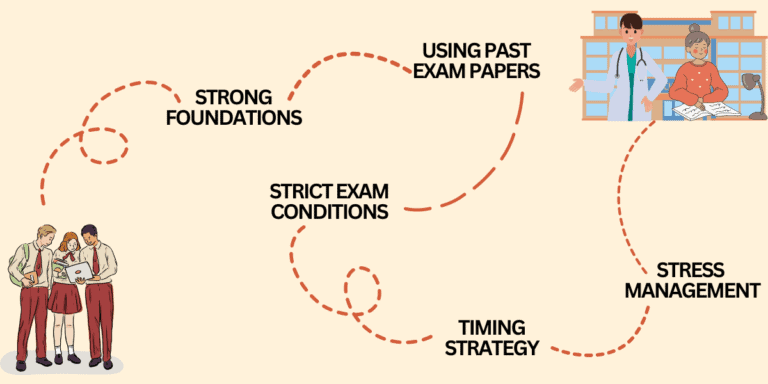The International Medical Admission Test (IMAT) is realistically the biggest hurdle between you and studying medicine in Italy. Every year, thousands of prospective international medical students attempt this exam in hopes of being admitted to an English medical program in Italy, and are met with either joy or heartbreak. In this article, you will find not only the strategies of successful students scoring in the top percentiles but also the regrets and mistakes of students who were not able to clear the exam this time around.
I asked thousands of IMAT takers through our official Instagram account two simple questions to study the trends between two groups: What did the successful students do that they attributed their success to, and what do the students who didn’t achieve the score they hoped for think caused their downfall? Adopting the strategies of successful students will, of course, be helpful to increase your score, but avoiding common mistakes and pitfalls of others will go a long way in maximising your potential points and becoming a medical student in Italy.
When analysing the answers of both top scorers and students who didn’t do so well, there were some interesting emerging trends, and more interestingly, the most common trends from both groups were essentially mirrors of each other. In this article, we’ll go through each of the most common factors students mentioned and the differences between the two groups in their overall success for the IMAT.

Using Past IMAT Papers
The approach to using preparation material, and more specifically past exams, was by far the most common answer in both groups and the most glaring example of trends in the opposing groups mirroring each other. From the higher-scoring group (HSG), the resounding common success factor was that they all used past papers religiously, and even more so in strict exam conditions, sometimes even allowing 10 minutes less time than a real attempt would have permitted them. Among the lower-scoring group (LSG), the most common answer was that they did not use past papers enough.
While the overarching theme in the LSG was about not using the papers at all, which is unfortunately a huge mistake as they’re probably the best resource available, some students emphasised that they didn’t appropriately simulate exam conditions. As mentioned in the in-depth article on how to use past IMAT exam papers, this is one of the most important things you can do. This serves not only to train yourself to get used to sitting down for long periods of focus without breaks, but also because it helps with familiarity and exam routine, which can significantly reduce exam nerves. Additionally, it helps in recognising trends, understand high-yield topics, and practicing different exam strategies.
There’s a lot more in-depth information in the article ‘IMAT Past Papers’ on how to go about this, which you should read for more, but to give a summary of the most important points:
- Use a physical timer like a wall clock, not a phone or wrist watch during your trial.
- If you already know your exam centre and time, do out your routine as you would on the exam day every single time you attempt a past exam (same wake up time, same breakfast, calculate travel time, workout if you normally do etc.)
- Try to do the exam in a library where there will be a lot more people for some possible noise, but still not too noisy.
- Do not allow yourself any extra time during a trial.
- Try not to take bathroom breaks or drink water, as on the day breaks will greatly effect your available question solving time, and you will probably not have access to water.
The strategy of the HSG didn’t stop at using past exams in stellar conditions, but their strategy around every attempt was also much more robust. Again in our past IMAT exams article we delve into this deeper, but an overview of the best strategy can be summarised as:
- Review each completed exam to see what questions were answered wrong
- Subsequent analysis of which topics are indicating knowledge gaps
- Review these topics
- Reattempt questions
- Repeat for every subsequent exam
Nailing Down Time Management for the IMAT
Time management was probably the most heartbreaking issue to read about, as some individuals disclosed crying during the exam, realising they had no way of finishing the questions. Many students in the LSG mentioned either not having enough time or spending significantly more time on a section than they had originally intended. Of course, correlation does not imply causation, but it’s probable that this point is strongly related to the lack of using past exam papers under appropriate exam conditions. It’s unlikely that a student who has practiced an exam within time constraints 10+ times would struggle significantly more on the actual exam day. This is not only due to adrenaline, which would likely accelerate their pace, but also because if this was an issue it would have likely arisen much earlier during preparation, allowing them to address it.
There are many approaches to improving time management and mastering question timing, but I think the most effective would be to prepare under even stricter timing conditions and to have a solid strategy that you’re going to stick to on the day. To expand on the first point, this could involve trying to complete the exam in ten fewer minutes than usual or perhaps setting a time limit for each section based on your strengths and weaknesses, allowing you to reduce time spent on each section to make preparation more challenging. Being accustomed to even more limited timing conditions, especially on harder questions, will provide a safety net on the day if you’re moving too slowly or need to correct mistakes (or to tackle the infamous ‘staple conspiracy’ of the 2023 exam).
When it comes to the ‘strategy’ portion of addressing this mistake, it can look very different for different people. What’s more important is that you test out a few different strategies and find out what works for you, and most importantly, STICK TO IT instead of making last-minute changes on the day. Some examples of different strategies can be:
- Set a specific time limit for each section; once the time is up, move on to the next section no matter what.
- Have a set time limit for the entire exam that will allow you to have leftover minutes to then review all your answers at the end.
- If a question looks too difficult to skip it and come back at the end ONLY if you have enough time. This ensures that you’re maximising time on correct answers that will lead to a bulk of the points anyway.
While conducting research for this article, the evidence I found supporting the most optimal strategy was moderate at best. However, it is overwhelmingly clear that consistently practicing one strategy will yield the highest return on your preparation investment. Depending on when you come across this article and learn about the exam, experimenting with different strategies may be challenging. In such cases, it’s advisable to select a strategy that seems most reasonable to you personally and stick to it during practice with past exams.
IMAT Exam Day Strategies
This topic was mentioned much more frequently by the LSG compared to the HSG. The recurring themes around this issue among the LSG were guessing too many questions, not taking negative marking seriously enough, and not reading the questions thoroughly. As we know from the structure of the IMAT, every correct question earns 1.5 points, but many students fail to grasp the impact of the -0.4 negative marking. Although it may seem like a small deduction, it’s important to realize that these negative points start stacking up rapidly. It’s worth noting that answering only 30 questions correctly could secure entry into most universities, especially if there are no incorrect answers. While this is particularly true for EU students compared to non-EU students (given recent score trends), achieving 45 points would still position one competitively for admission to most of the less competitive universities.
The IMAT is an exam that rewards conceptual understanding rather than rote memorisation. While some biology exams worldwide may adopt a straightforward true-or-false approach or focus on regurgitating memorised information such as asking for definitions, the biology section of the IMAT resembles a logical reasoning exercise. Taking a look at the example question below, it’s clear that the question isn’t as simple as asking about just cell growth; instead, it requires the application of theoretical knowledge about cell growth to a practical logic involving proportions and maths.

Many students from the LSG mentioned that they did not read the questions thoroughly enough or failed to take the time to understand them. Given that the IMAT rewards conceptual understanding with tricky questions that go beyond rote memorisation, investing time to comprehend the question and work out its logic pays dividends. Alternatively, refraining from guessing answers is quite important, as even a few guesses can make the difference between getting in and taking a gap year.
Foundational Knowledge for the IMAT Exam
Interestingly, the level of knowledge was one of the points mentioned the least overall in both groups. HSG did mention that they had very strong foundations and basic theory, particularly in organic chemistry and biology. This makes sense since, as previously mentioned, the IMAT rewards conceptual knowledge more than rote memorisation for these sections, allowing for the application of basic theory to more creative problems. For those interested, we have an entire article dedicated to recommended study resources for the IMAT (including free books and courses) that can help build your basics.
Conversely, the LSG mentioned a lack of basic theory for biology or completely disregarding the math and physics section. From a strategic standpoint, if preparation time is limited, it makes sense to ignore this section as it yields the fewest points. The 2023 IMAT paper had the highest number of questions compared to previous years, totalling 12 (a potential 18 points). This implies that with the split, either physics or math would be the lowest yield to study, instead of focusing on other sections to maximise potential points. However, as students who have completed all past papers will note, certain topics are very often repeated especially in the maths and physics section.
A good balanced approach, based on the total tally of responses mentioning this topic, would be to use a solid level of study material (especially A-level and IB) to establish a strong foundation. If time is limited, focusing only on the highest-yield topics for smaller sections like math and physics would be advisable. However, once again it’s crucial to note that it’s impossible to gauge the sufficiency of the knowledge you’re building without applying it in practice through past papers.
Stress Management

The final and most crucial, yet often overlooked aspect of exam preparation, is the general approach to stress management and lifestyle factors. Many students mistakenly equate suffering with hard work and believe that continuous pressure is necessary to succeed. However, this mindset is misguided and ultimately detrimental to preparation efforts. Stress and exhaustion are a fast track to burnout. Notably, the HSG emphasised the importance of maintaining a good routine, prioritising sleep, rest, exercise, and taking part in stress-relief activities. Conversely, the LSG highlighted the detrimental effects of stress buildup, such as blanking during exams or experiencing sleep deprivation, which impacts mental effort in both studying coming up to the day, and during the test.
I really want to stress this point because it’s not just about doing well on the IMAT; it’s about your overall happiness and well-being as a student. You shouldn’t sacrifice your happiness and mental health for anything, not even for studying medicine. The habits you form now will shape your future. They’ll also play a big role in how you handle the pressures of medical school later on. So, it’s super important to prioritise taking care of yourself and managing stress. It’s not just about passing the IMAT; it’s about setting yourself up for success in medical school and beyond.
Good luck future doctors!


2 thoughts on “IMAT Code for Success: Strategies of Top Scorers”
hello!!! Are the past imat papers enough to study efficiently or do I need extra material? If so , what do you recommend?
The past papers are the most important factor, we recommend these IMAT study resources for additional work!